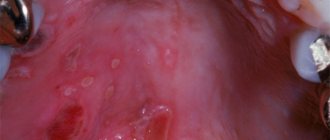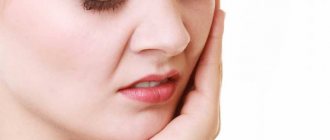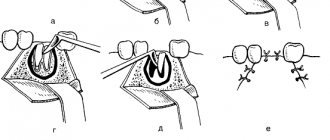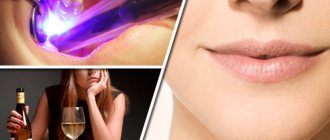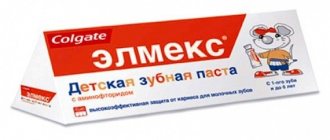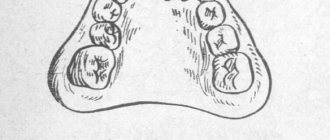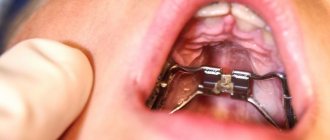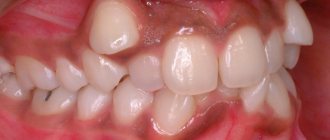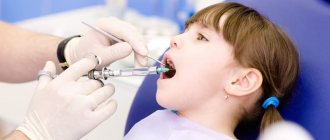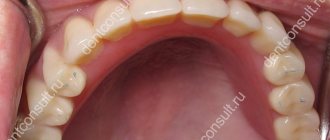Functions of the sky and structural features
The palate is a vault that separates the oral cavity from the nasopharynx.
The structure of the palate consists of two sections - hard and soft. This organ performs an important function - it prevents food from entering the nasopharynx from the oral cavity. In addition, receptors on the surface of the palate are associated with the larynx and take part in articulation and influence the timbre of the voice and the pitch of sounds.
Thus, the inflammatory process of the upper palate disrupts all the functions of this important organ, and therefore requires mandatory treatment.
MZ: Medicine and Health
There are various types of shortening of the hard and soft palate. There may be a short hard palate and a normal soft palate, a normal hard palate and a short soft palate, as well as simultaneous shortening of the hard and soft palate [Kaplan, Jobe, Chase, 1969]. These changes may be combined with a cleft uvula. Cleft uvula was found in 1% of 10,836 children [Weatherley-White, Sakura, Brenner, Stewart, Ott, 1972]. When examining the same group of children, Stewart, Ott and Lagace (1972) found cleft uvula without other pathology in 100 children, in combination with a submucosal cleft palate in 8 and in combination with a cleft lip in 2. Meskin, Gorlin and Isaacson (1964 ) identified cleft uvula in 1.34% of 1864 dental patients of all ages and in 1.47% of 7837 university applicants. Chosak and Eidelman (1978) studied 70,359 schoolchildren aged 6–18 years in Israel. Cleft uvula was detected in 0.44% of children of both sexes, 7.7% of their parents and 7.5% of siblings. According to Taylor (1972), a cleft uvula clearly indicates disturbances in the embryogenesis of the palate and associated structures. Schendel and Gorlin (1974) showed that cleft uvula is more common in patients with Down syndrome than in the general population. Of the 389 patients with Down syndrome, 18 (4.63%) had this pathology.
Enlarged throat
In some children with a normal hard and soft palate, the pharyngeal cavity is too deep, causing velopharyngeal valve insufficiency. Calnan (1971b) reported on 36 children aged 5–7 years and 5 adults who spoke nasally and showed no obvious changes in the structure of the palate and pharynx. However, clinical and cephalometric studies revealed an increase in pharyngeal size. Calnan called this condition congenital enlarged pharynx. After pharyngoplasty, speech returned to normal in more than 60% of patients. Shapiro (1980) observed a boy aged 11.5 years who had mild hypernasality without nasal air for 1.5 years. Lateral X-ray cephalometric examination revealed a very deep nasopharynx, a slightly shortened palate, and an almost complete absence of adenoid tissue. Speech therapy correction of articulation disorders not associated with hypernasality was carried out over several months. When examining the child after 7.5 months, it was found that hypernasality had completely disappeared. The author explains this spontaneous disappearance of hypernasality by the compensatory capabilities of the body.
Jackson, McGlynn, and Huskie (1980) reported on 20 children with velopharyngeal insufficiency who had no evidence of cleft palate.
Palatal palsy
14 boys and 6 girls aged 5-14 years had the same voice changes that occur with a cleft palate, but they were caused by the following reasons: a short soft palate and as a result - velopharyngeal insufficiency, a condition after adenoidectomy and uncoordinated movements soft palate. Sphincter pharyngoplasty was performed in 18 children, and 16 of them had improved voice. With the help of pharyngoplasty and speech therapy correction, it was possible to normalize speech in 10 out of 20 children.
With a normal structure and size of the soft palate, partial or complete paralysis may occur, leading to complete immobility or lack of function. For isolated paresis of the soft palate, Schweiger, Netsel and Sommerfeld (1970) recommend a prosthesis that lifts the soft palate upward and completely covers the pharynx in the anteroposterior direction. There are gaps on the sides, thanks to which normal breathing and the reproduction of nasal sounds m, n occur. Kerman et al. (1973) described the successful use of a prosthesis in two neurological patients with severe dysarthria.
Submucosal cleft palate
Submucosal cleft palate is a congenital defect characterized by a violation of the structure of the muscles of the palatine curtain [Calnan, 1954]. In this case, the same resonance and articulation disturbances occur as with an open cleft palate. Arnold (1965) described the external signs of a submucosal cleft palate. In this case, the uvula may be normal or split; in the posterior part of the hard palate there may be a triangular defect covered with a mucous membrane that is normal at first glance. In fact, the mucosa is thinned due to the lack of muscle fibers underneath. During phonation, it stretches and the bone defect becomes visible. Sometimes, to diagnose the defect, it is necessary to perform transillumination using a nasopharyngoscope, which often reveals a soft palate that is too short and weak, which is not able to rise and close the nasopharynx. According to Beeden (1972), a cleft tongue is observed in almost all cases, and a defect of the hard palate is observed in all cases of submucosal cleft palate. According to Calnan (1954), a submucosal cleft palate is characterized by the presence of a cleft uvula, a bone defect of the hard palate and diastasis of the palate muscles.
“Development of hypernasality. Adenoid removal ||| Cleft palate »
Why does inflammation occur?
The muscular structure of the palate is covered on top with a mucous membrane, which is subject to the development of an inflammatory process. Inflammation often occurs under the influence of such factors:
- burn of the mucous membrane as a result of consuming excessively hot food and drinks;
- damage to the palate due to dental diseases - periodontitis, stomatitis, caries, pulpitis;
- disruption of the oral environment due to the action of metals - when wearing braces or installing crowns;
- smoking;
- allergic reactions to medications;
- neurological diseases affecting the joints of the upper or lower jaw;
- osteomyelitis - an infectious lesion of the bone tissue of the jaw;
- malignant neoplasms;
- infectious diseases of the upper respiratory tract - sore throat, tonsillitis, pharyngitis, rhinitis.
The development of the inflammatory process of the palate may be facilitated by some of these causes in their entirety or separately from each other.
Yellow palate in the mouth of an adult
If the sky has turned yellow, you should see a dentist. During the examination, the specialist will determine whether the yellowness of the mucous membrane is a sign of any disease, or indicates a lack of proper oral hygiene.
The patient’s attitude towards bad habits is also taken into account. Yellowness with a pronounced network of veins is often formed as a result of regular smoking.
When conducting diagnostics, the patient's age is taken into account. In people over 50 years of age, the appearance of yellow plaque on the palate is considered a physiological process, so serious health problems are not always detected.
Read also: What to drink orange liqueur with
The child has
A yellowed sky appears not only in adults, but also in children. In addition to dental problems, this sign may indicate other diseases, so the child should be shown to a gastroenterologist, ENT specialist, pediatrician, infectious disease specialist, or hepatologist.
Often, young patients with this symptom are diagnosed with thrush. If there is any doubt in determining the problem, it is recommended to undergo a full examination, including donating blood to check bilirubin levels.
Signs and symptoms of inflammation of the palate
Depending on the causes of inflammation in the oral cavity, a person may experience the following unpleasant symptoms:
- A feeling of acute pain that makes it difficult to eat. Soon the pain increases, sometimes even swallowing becomes impossible.
- If the inflammation is caused by the action of a fungus, a white coating and erosion forms on the surface of the palate. The process is accompanied by an unpleasant putrid odor from the mouth.
- When the cause of inflammation is an infectious lesion - sore throat or tonsillitis, the palate becomes red and swollen.
- In case of acute inflammation, an increase in body temperature and fever is possible.
- If the cause is dental disease, the patient will be bothered by toothache.
- With cancer, the patient complains of aching pain in the palate.
How to treat inflammation of the palate depends on the causes of the development of the inflammatory process and its symptoms. To determine an accurate diagnosis, you should visit a specialist's office.
Causes
The palate area, like other areas of the skin and mucous membranes, is characterized by a strong blood supply, which is due to the presence of a dense network of capillaries.
The normal color formed on the surface indicates the absence of an inflammatory process in the body and other serious disorders. A change in the color of the palate is a manifestation of the symptoms of the disease, which is determined after the study.
The reasons that provoke the formation of yellowness can be found in the table:
| Reasons for the formation of yellow plaque on the palate | ||
| Reason name | Description | Additional symptoms |
| Liver diseases | The most common liver diseases, recognized by the yellowness of the palate, are: jaundice, cirrhosis, cholecystitis, cholelithiasis and syphilis. When an organ is damaged, disruptions in the functioning of all systems and metabolic processes occur: protein, carbohydrate, fat, pigment, etc. Depending on the disease, the corners of the palate and the boundaries between soft and hard tissue (with cholecystitis, bile stones) or the entire surface of the mucous membrane turn yellow. (for hepatitis). |
|
| Pancreas problems | The organ regulates energy exchange and biochemical processes occurring in the human body. If there are problems with the pancreas, one of the main signs appears - the soft palate acquires a bronze tone. If malfunctions occur in the biliary system, the color is combined with pronounced jaundice. |
|
| Intestinal inflammation (large/small) | Yellowness on the upper palate with intestinal dysfunction appears due to the morphofunctional unity of the oral mucosa and the gastrointestinal tract. The color of the palate changes to yellowish both in individual zones and over its entire surface. The neglect of the disease is reflected in the intensity and structure of plaque. |
|
| Kidney failure | The main provocateurs of renal failure: urolithiasis, diabetes mellitus, pyelonephritis, neoplasms, lipid metabolism disorders. As a result of a failure of metabolic and biochemical processes, yellowness appears on the hard palate. Additional symptoms help determine whether the kidneys are involved in the problem. |
|
| Cholesterol and fat metabolism disorders | Cholesterol metabolism disorders are accompanied by a change in the color of the soft palate from pink to yellow. At the same time, gray lumpy spots are clearly visible on the surface of the mucosa. Failures in fat metabolism are recognized by a pale icteric coating on the palate. The main provocateurs of metabolic disorders are: tuberculosis, diabetes, oncology. |
|
| Smoking | The color of the palate changes under the influence of resins, which are included in tobacco in high concentrations. A bad habit provokes disruption of blood circulation and biochemical processes in tissues associated with disruption of metabolic and other processes. The mucous membrane loses its pink color and becomes yellow. |
|
Diagram of the oral cavity
How is inflammation of the palate treated?
How to treat inflammation on the roof of the mouth, a specialist will tell you after determining the diagnosis. The following therapy methods can be used:
- If the cause of inflammation is minor damage to the mucous membrane, rinsing with decoctions of medicinal herbs is usually sufficient. Decoctions and infusions based on calendula, sage and chamomile have an antiseptic and healing effect. The herbal decoction for rinsing should be used warm.
- When the palate is affected by a fungus, patients are prescribed topical agents. The most effective are the solution and gel “Chlorhexidine”, “Rotokan” or “Stomatofit”.
- In case of severe pain symptoms, regardless of the cause of inflammation, drugs of combined action are prescribed. “Cholisal-gel” and “Kalgel” have proven themselves well.
- If a purulent inflammatory process is detected in the oral cavity, the patient is prescribed antibiotics. The minimum course of treatment is usually 7 days, but there are also stronger drugs that only need to be taken for 3 days. Along with local agents, antibacterial drugs for internal use - Sumamed, Flemoxin Solutab - can be prescribed.
- The inflammatory process of the palate is easily treatable. The earlier therapy is carried out, the less likely it is to develop complications.
Treatment
The results of the patient's studies indicate a problem existing in the body.
A specialist with a narrow profile will be able to prescribe treatment: nephrologist, gastroenterologist, urologist.
If signs of a systemic disease are detected (syphilis, rheumatism, HIV, etc.), a referral is given to the hospital of a specialized medical institution.
When oncology is detected, a treatment regimen is developed jointly with other specialists: a surgeon, oncologist, neurologist, ophthalmologist, etc.
Diagnosing a local viral infection on the oral mucosa involves prescribing antiseptics and antibiotics to suppress the inflammatory process and destroy the pathogen. The same drugs are used to treat periodontitis, gingivitis and in cases where it is necessary to prevent ulcerative-necrotic complications.
Whatever treatment method is chosen, the doctor also prescribes oral hygiene procedures:
- professional cleaning;
- selection of products for daily hygiene of the dentition and oral mucosa;
- regular rinsing with an antiseptic solution.
An equally important step is strengthening the body’s protective functions. For these purposes, regular intake of vitamin complexes is suitable, which promptly replenish the deficiency of essential vitamins and minerals.
